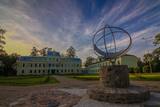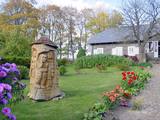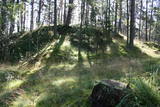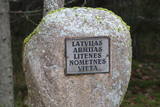| Nr | Name | Beschreibung |
|---|---|---|
|
Pirmie dokumenti par Kokmuižu atrodami 1601. gada zemes revīzijas pierakstos. Tur sniegtā informācija vēsta, ka Kokmuiža pastāvējusi jau 1560. gadā. Taču 1880. gadā vācu muižnieks sākas celt kungu māju neobaroka stilā. 20. gs. sākumā tā tika izpostīta, bet 1937. gadā to pārveidoja par skolu. Kokmuižā kādreiz atradusies alus darītava. Tas bija laika periodā no 17.- 20. gs. Tā bija viena no slavenākajām alusdarītavām visā Vidzemes guberņā. Mūsdienās var izstaigāt muižu pats vai gida pavadībā. Var aplūkot kungu māju, staļļu ēkas, muižas pārvaldnieka namu, bibliotēku, ekspozīciju, abas klētis un alus darītavas pagrabu, kā arī sfērisko saules pulksteni.
|
||
|
Das Museum wurde 1968 eröffnet. Der Obstgarten ist ein untrennbarer Bestandteil des Hofes, der von den Museumsmitarbeitern gehegt und gepflegt wird. |
||
|
Ziedonis Kārkliņš, der einer der Autoritäten und Lehrern unter den Saunameistern ist, verwendet bei seinen Ritualen die energetische Wirkung von verschiedenen Saunabesen. In einer Sauna werden 12 und mehr Saunabesen aus verschiedenen Pflanzen, natürliche Kosmetik und Materialien aus der Natur (Lehm, Bernstein, Schlamm, Steine u.a.) verwendet. Der Saunameister wendet alte energetische Zeichen der Balten an. |
||
|
Ein neues Cafe, das sich auf dem Gelände des Naturparks „Daugavas loki” in Naujene befindet. |
||
|
The farm "Veckūkuri" in Jērcēni parish of Strenči district is included in the top of the most productive herds in Latvia. "Veckūri" is a milk processor that produces non-traditional dairy products from the milk obtained on its farm. The farm is also ranked among the companies that have been awarded the State Export Council awards “Latvian Export Product 2015”. |
||
|
Atrodas Rīgas – Ventspils autoceļa (A 10) 88. kilometrā, pašā Abavas krastā. Pie stāvlaukuma interesants objekts – senais Zemgales un Kurzemes robežstabs un vēsturisko novadu robeža. Piedāvā kempinga pakalpojumus. |
||
|
Unweit von der Mündung des Flusses Kilmiņupe ins Meer befindet sich die sagenhafte Wallburg des Seeräubers Trommel – eine mittelalterliche Befestigungsanlage. Die ist etwa 100 m vom Hof „Kraujas” zu finden. Die 1977 hier während der archäologischen Ausgrabungen gefundenen Ziegelteile und Scherben von Ofentöpfen zeugen, dass die Befestigung schon im Mittelalter existierte. Dieser Ort ist mit den Sagen über den Seeräuber Trommel verbunden, der hier das Raubgut vergraben hat, deswegen sind an der Düne viele von den illegalen Archäologen ausgegrabene Gruben zu sehen. Eine Sage erzählt über den Seeräuber Trommel, der mit seinen Leuten die Schiffe in der Rigaer Meeresbucht von der Kurlands Küste bis zu der Insel Roņu raubte. Im Altertum ankerten hier viele Schiffe, die auf den günstigen Fahrwind warteten, um das Kap von Kolka umzugehen, aber der Seeräuber nutzte es mit einem eigensüchtigen Ziel aus. Er sammelte auch die Güter von den versunkenen Schiffen. Die Burg von Trommel wurde aus Stein gebaut. (Die Quelle: Roja TIZ) |
||
|
Biškopības produkti bioloģiskajā saimniecībā, informācija par biškopību un dabas aizsardzību. |
||
|
Die Hausherren des Hofes Sonnentor sehen sich in der Tradition einer vorchristlichen Kultstätte und veranstalten Rituale im Einklang mit der jährlichen Entwicklung der Natur. Daneben gibt es Vorträge zur alten Religion der Balten. Kalenderfeste und Familienfeiern können hier abgehalten werden – Hochzeiten, Brautabende, Segnungen, Wintersonnenwende, Fastnacht. Im Hof werden heidnische Feste veranstaltet. Die Kurse sind eher für Erwachsene gedacht. |
||
|
Hiiu Gourmet ir mazs uzņēmums, kura mērķis ir piedāvāt produktus no vietējām izejvielām Hījumā. Izstrādājumi tiek izgatavoti ar rokām mazos daudzumos. Produktu klāstā ir mājās gatavoti sīrupi, piedevas, sinepes utt. No augiem un ogām, kas novāktas Hījumā mežos. Saimniece Heli padāvā Hījumā tradicionālā ēdiena gatavošanas meistarklases. |
||
|
Radošajā mājā Latvietes pūrs var apgūt praktiskās iemaņas rokdarbu veidos, kas nepieciesami latviešu tautas tērpu darināšanai – baltie un krāsainie darbi, zīļu vainagu darināšana, adīšana, tamborēšana, tilla izšuvumi, pīto un austo jostu darināšana u.c. Saimniece pati pārzina dažādus rokdarbu veidus un to tehnikas, nepieciešamības gadījumā tiek pieaicināti sava aroda meistari. Ir zināšanas par latviešu tautas tērpa novadu īpatnībām, saimniece labi zina tautas tērpu attīstības vēsturi un pielietojumu
|
||
|
We offer a private collection of ancient tools, household items and technologies which we began to assemble in 2002. Right now we have more than 5,000 objects of cultural and historical objects on display, as well as a lovely garden with countless compositions of colourful flowers, fountains, an Eastern meditation bridge, ponds, a pergola, leafy areas, etc. The garden covers more than 2 ha, and it is located 1 km from Lazdukalns. |
||
|
Ap 100 gadus veca priežu audze, ko iesēja pagājušā gadsimta sākumā. Sēklu materiāls bija nācis no kādas Vācijas (Darmštatē) sēklu tirdzniecības firmas. Mūsu klimatiskajos apstākļos priežu stumbri izauga līki un kroplīgi. Savdabīgā audze labi redzama no šosejas malas.
|
||
|
Familienrestaurant 12 km von Talsi entfernt, wo Sie traditionelle lettische Küche probieren können. |
||
|
Der botanische Park Palanga umgibt das Bernsteinmuseum in Palanga. Er ist einer der schönsten, reichhaltigsten und am besten gepflegten Parks in Litauen. Begründet wurde er aus dem Birutė gewidmeten einstigen Bannwald und war daher lange Zeit im Volksmund als Birutė-Park bekannt. Er hat ein Areal von 101,3 ha. Der mit Talent entworfene Park zeichnet sich durch große landschaftliche Vielfalt aus, mit meisterhaft gewundenen Pfaden, Blumenrabatten auf den Plätzen, 2 Teichen und Elementen der Kleinarchitektur. |
||
|
Das Geschäft in Jelgava bietet biologische, natürliche Lebensmittel, gesunde Produkte für Kinder, glutenfreie Produkte, ökologische Kosmetik und Reinigungsprodukte an. Angeboten werden Produkte aus natürlichen Zutaten vonlettischem Landwirten und Heimbetrieben. |
||
|
Muiža sāka veidoties 16. gs. beigās (īpašnieki - Tīzenhauzeni, vēlāk Bēri), bet no 1753. g. tā kļūst par Mēdemu dzimtas īpašumu. Tagad redzamo muižas pili (mūsdienās tikai atliekas) cēla 1806. - 1810. g. klasicisma stilā (Johana Georga Ādama Berlica projekts) pēc itāļu izcelsmes Pēterburgas galma arhitekta Džakomo Kvarengi meta. Muižas īpašnieks tajā laikā bija Johana Frīdriha Mēdema dēls - Kristofs Johans Frīdrihs (saukts par Žanno). Elejas pilī bija savākti daudzi nozīmīgi Eiropas mākslinieku darbi, kā arī iekārtots izcils interjers. 18 muižas kompleksa ēkas nodedzināja Pirmā pasaules kara laikā (1915. g.) un līdz mūsdienām ir saglabājušies tikai nelieli pils pirmā stāva drupu fragmenti ar kaltiem portika kolonu kapiteļiem, pārvaldnieka māja (apskatāma no ārpuses), atsevišķas saimniecības ēkas un parks. No pils drupām pa aleju var aiziet līdz Tējas namiņam (bēdīgā stāvoklī). 0,5 km ziemeļos no pils drupām atrodas 1912. g. izveidotā Mēdemu dzimtas kapsēta. Elejas pils mūra žoga arkādē iemūrēts dobumakmens. |
||
|
Der Name von Litene ist mit tragischen Seiten der lettischen Geschichte verbunden. In den 1920er bis 1930er Jahren befand sich unweit von Litene ein Sommerlager der lettischen Soldaten, wo im Sommer 1941 lettische Offiziere unter dem Terror der Sowjetmacht gelitten haben: Fast 500 lettische Offiziere wurden nach Norilsk in Sibirien geschickt, ein Teil wurde erschossen und heimlich in den Wäldern der nächsten Gegend begraben. Am Ende des Sommers 1941 hat hier die Armee von Hitler ungefähr 300 Menschen aus der Zivilbevölkerung, hauptsächlich Juden, erschossen. Heute sind hier zum Andenken der Getöteten Gedenkstätten eingerichtet worden. |
||
|
Die Tour führt durch Nationalparks und Naturschutzgebiete von internationaler Bedeutung entlang der Küste. Unterwegs werden kleine reizvolle Städte, einige historische Sehenswürdigkeiten und traditionelle Dörfer besucht. Auf der Tour erkunden Sie seltene und geschützte Pflanzen und örtliche Traditionen, sowie genießen wunderbare Landschaften, die Wildnis und Einsamkeit. Im Nationalpark Kemeri gehen Sie auf einem Pfad im Moor, sehen wilde Wiesen und können einen Vogelbeobachtungsturm neben dem See Kanieris besteigen. Danach erkunden wir den Naturpark des Sees Engure, wo man 22 Orchideenarten finden kann. Am nächsten Tag führt die Tour Richtung den Nationalpark Slitere, der das ehemalige Gebiet des Baltischen Eisstausees und des Littorina Meeres ist. Sie besuchen den Kiefernpfad des Kaps von Kolka und den Pfad des Sees Peterezers, in dessen Landschaft man die Bildungsperioden der Ostsee sehen kann. Weiter führt die Tour zum Pfad des Moores Stikli, das das größte Moorgebiet in Lettland ist. In Uzava entdecken Sie die größte graue Düne in den baltischen Staaten und die wilden Ufer des Flusses Venta, aber danach – die reizvolle Stadt Kuldiga, die mit ihrer gut erhaltenen hölzernen Architektur und dem breitesten Wasserfall in Europa bekannt ist. Weiter führt die Tour durch das Urstromtal Abava, das von tauenden uralten Eismassen gebildet worden ist. In Sabile können Sie an dem berühmten Weinberg halten, der der nördlichste Weinberg der Welt ist, und an dem Pflanzenpfad von Sabile, aber weiter auf der Tour – an der größten Eiche in Europa. Auf dem Weg nach Riga unternehmen Sie eine Wanderung auf dem 5 km langen Pfad des Moores von Cena, das Nieder-, Hoch- und Übergangsmoore, sowie die dort waschenden Pflanzen charakterisieren. |
||
|
Krodziņš "Mežavējš" atrodas Rīgas - Liepājas šosejas 101. kilometrā. Krodziņa ēdienkartē iekļauti latviskie ēdieni. Latviešu virtuve: Skābu kāpostu zupa, biešu zupa, skābeņu zupa, aukstā zupa, kartupeļu pankūkas, plānās pankūkas ar ievārījumu, šmorētas cūkgaļas ribiņas, zemnieku cienasts, mājas kotletes, auzu pārslu kārtojums, rupjmaizes kārtojums. |
||

























